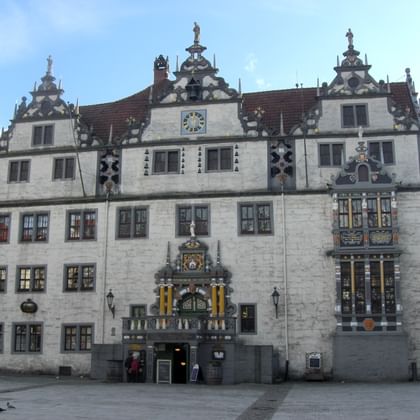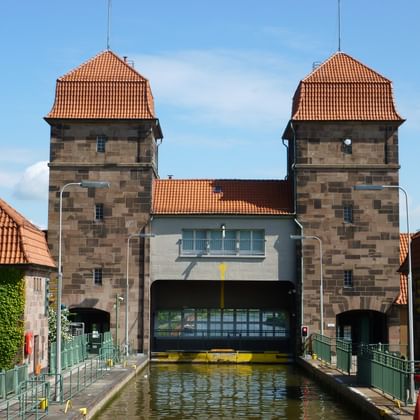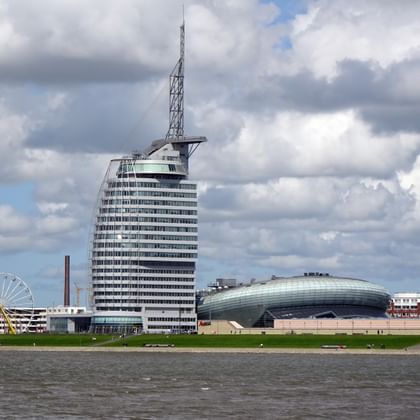Itinerary
Individual arrival in Hann. Munden. In the late afternoon, the information meeting and the delivery of the bicycles (if booked) will take place. A first introductory tour by bike would be in the old town of Hann. Munden already belongs to the possibilities. A walk through the medieval centre of Hann. Münden with its historic half-timbered houses from the Weser Renaissance is highly recommended.
Start your cycling tour on the Weser route exactly where the Werra and the Fulda "kiss" each other. The first stage leads via Hemeln and past the former Benedictine monastery of Bursfelde to the baroque Huguenot town of Bad Karlshafen. The centre of Bad Karlshafen with its attractive renovated Baroque-style houses offers an interesting contrast to the other half-timbered idyll.
There are plenty of highlights along the way: the town of Fürstenberg with its porcelain factory and the old Hanseatic town of Höxter with more than 160 listed buildings, mostly half-timbered houses. The small town of Beverungen has retained much of its historic appearance. Holzminden is known for the production of aromatic essences and perfume oils.
Many romantic villages invite you to linger. Corvey Castle, the former Imperial Abbey near Höxter, offers an attractive mix of art and culture. The romantic town of Bodenwerder became famous for the so-called Reclining Baron of Munchausen. The famous Pied Piper town of Hamelin enchants with its intact old town, beautiful half-timbered houses and buildings in the typical Weser Renaissance style from the 16th and 17th centuries.
At Porta Westfalica, the river breaks through the Wiehen and Weser Mountains and the Weser reaches the northern German lowlands. Along the way, the town of Rinteln from the 13th century offers numerous Weser Renaissance buildings. Minden was once a thriving trading town in the Middle Ages but was badly destroyed in World War II. After the war, the city was completely rebuilt as part of the redevelopment.
After the low mountain ranges, a romantic, protected floodplain landscape predominates; the Mittel-Weser. You can look out over the flat land with pastures, black and white spotted cows, remote farms and countless windmills. The strong fortifications were characteristic of Nienburg and the beautiful old town is still very worthwhile.
The historic landscape of the Mittel-Weser, the county of Hoja, is crossed today on your Weser route. In this distinct Weser stage, you will find original villages and isolated farms. After this natural part, the equestrian town of Verden is a crowning achievement of this day. The symbol of this city is the cathedral. Verden is today known as an important town for equestrian sports.
Away from the main roads and through park-like areas, you can reach the centre of Bremen without being bothered by car traffic. As the second largest North Sea port, the city is of great importance in shipping and overseas trade. A visit to the old town is worthwhile. The Schnoorviertel, the Roland and the monument to the town musicians of Bremen are certainly worth a look.
From Bremen follow the Weser cycle path through Lemwerder and to Elsfleth with the famous Hunte barrage.
The route continues along the Weser via Brake to Nordenham. Take the Blexen ferry across to Bremerhaven. The Emigration Center (exhibition on emigration from Germany to America in the 19th century), the Climate House (virtual journey around the world on the theme of climate) and the Maritime Museum await you here. If you have time to spare, visit the submarine Wilhelm Bauer, which is located in the harbour as a museum.
Your tour leads via tarmac paths and streets through the Wursten country to the dune coast of Cuxhaven. The busiest shipping route in the world and the museum harbour make Cuxhaven a maritime metropolis.
Departure from Cuxhaven or spend extra nights in the city or surrounding region.
Route map and overview
The Weser cycle route mainly runs on low-traffic roads and traffic-free asphalted cycle and freight routes. There are only slight differences in height to overcome and this bike tour is therefore also highly recommended for beginners and families with children.

Prices and dates
Accommodation in 2**, 3*** and 4**** hotels
Prices shown exclude bike hire
Hotel lists are available on request for all holidays
Services & Information
Further information about this cycling holiday.
Included
- 11 nights in the chosen category, including breakfast
- Personal welcome meeting (German)
- Luggage transfer(s) max. 1 piece of luggage 20 kg per person
- Travel folder 1x per room (German with route and overview maps, detailed route description, places of interest, important telephone numbers, luggage labels)
- GPS data available on request
- Service Hotline
Not included
- Tourist tax, if applicable, to be paid locally
- (Optional) Return transfer by minibus to Hann. Münden, €119 per person, reservation required, to be paid on site and possible daily. Costs to bring your own bike €30 per bike
- Airport: Bremen, Cologne or Hannover Airport(s)
- Train: Hann, Munden station
- Parking: Parking subject to availability, public parking near the hotel
- Return: For the correct train or bus connection see www.omio.com




